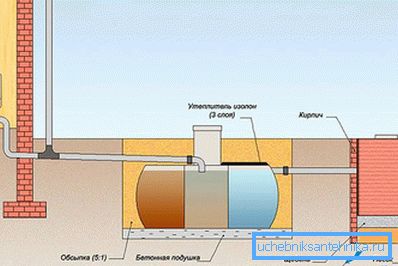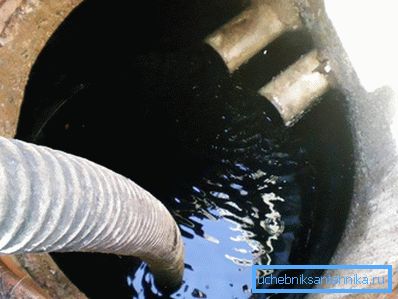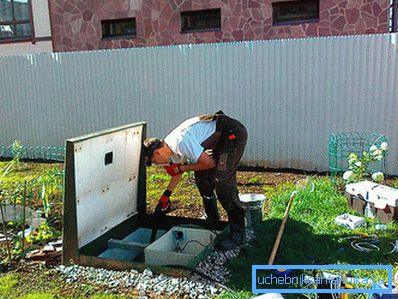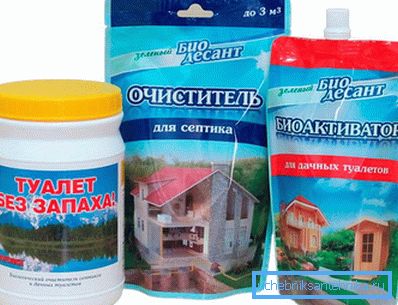How to clean a septic tank
Thanks to the septic tank it is possible to clean a large amount of waste water entering it. At the same time, the septic tank itself is also contaminated and may need to be cleaned. How to clean a septic tank to do everything correctly, creating the best conditions for its work in the future? To begin, consider what kind of structure - a septic tank?
A septic tank is a structure that lets flow through it, cleaning it inside. Speaking of "septic tank", it is usually meant relatively simple structures, through which fecal-domestic sewage flows. For their purification, anaerobic bacteria are used, which trap compounds that cannot dissolve and decompose them. The result is a sludge residue, it accumulates and it is worth removing it from time to time.
Septic tank design

Each septic tank can be called a settler, in which there can be one, two or even more cameras. Cleaning septic tanks are created using materials of various types. So, bricks, polyethylene film, steel structures with concrete can be used. This is all placed under the ground, leading to the construction of drains.
Such structures are usually installed when there is no possibility to join the city-wide sewer network, that is, mainly outside the city, in villages and areas where no sewage has been connected. In such septic tanks, all the waste water usually enters them, and there they undergo purification to the necessary degree, after which the water flows into the ground without contaminating it.
The principle of operation of the septic tank

Water is purified on a very simple principle:
- Fecal waste or household waste that flows out of the house goes inside the septic tank, where water does not immediately go to the next chambers, but settles for approximately one day. All particles that are in suspension, in the direction of movement in the following chambers, are gradually immersed on the bottom of the septic tank.
- A septic tank, which works on the principle of biological treatment, carried out at a deep level, colonize a special type of microorganisms, including anaerobic, living in settled particles. Over the course of a week or even two months, these microorganisms gradually process all settled drains into sludge.
- All waters that are clarified and discharged from suspended particles flow to the filter well, into which they are cleaned completely and then seep into the ground through the drainage layer.
What happens to the silt after the water leaves the septic tank? It accumulates and there is a need for periodic cleaning of the septic tank. Having understood the principle of operation of the septic tank, it is easier to figure out how to clean the septic tank.
Cleaning septic tank

How often to clean a septic tank - this is a question that most local sewer users ask. Planned cleaning of the septic tank is usually done once a year. In this case, the term “cleaning” does not imply the capital cleansing of the septic tank from sludge accumulated on its bottom. Experts advise to remove only 80% of sludge - the remaining accumulations will retain a sufficient number of microorganisms, which will allow the septic tank to work as usual.
If you clean the septic tank completely, you will have to re-colonize the bacteria inside the septic tank, which in itself is not cheap. Therefore, it is more practical to leave part of the sludge, saving your time and money.
Clean septic tanks like this:
- In the presence of sludge pipes, which are provided in some designs of septic tanks, sludge can be removed using such pipes. As a result, the sludge will flow by itself. If it does not go by gravity, then you can remove it under pressure.
- If there is no sludge pipe, then sludge is pumped out by sewers, which are sucked inside the septic tank by suction nozzles.
- The pipes themselves, which fit the septic tank, do not need to be cleaned - if the system is operated in the right way, then they will not form sludge plugs. If, however, there is a blockage in the pipe, you can resort to using the same assenizatorsky transport.
In long sewer pipes during installation it is important to make a well for their inspection, with which it will be possible to solve problems with blockages and other troubles. Also with the help of manholes, you can perform preventive cleaning of pipes. If during the installation of such a well was not made, but there is a need for it, then it is worth making an effort and build a manhole.
Sludge removal at a professional level

Assenizatorsky transport is not needed in all cases. For example, there are septic tanks without pumping, in which a system is installed for cleaning that allows you to remove solid particles automatically. In such a septic tank, all sludge deposits enter storage tanks, pumping through the filter system there. Such a system is quite simple and incredibly convenient, because a person does not need to puzzle over how to clean the septic tank.
All activity on the part of the owner of the house is reduced only to replacing removable tanks. Those that have already been filled to the top are removed, and instead they are set to empty. In fact, this is the whole cleaning process for such septic tanks. And how to understand that the tanks are filled? This can also be done without problems - visually by opening the lid in the septic tank over the tanks. True, the disadvantage of such a system is its considerable cost, but it pays off with the efficiency of a septic tank and ease of cleaning.
In any other constructions of septic tanks, the scavengers are the only possibility of cleaning, except, perhaps, equipment that allows you to remove the sludge yourself by the pumping method. The purchase of such equipment - pumps, hoses and nozzles - is advisable for those whose septic tank is filled quickly enough and needs frequent cleaning.
Cleaning with bacteria

It will be equally interesting to learn about the method of removing sludge in septic tanks, which is the use of bacteria. In fact, such bacteria do not so much remove the sludge as they prevent its formation inside the septic tank.
If such bacteria are present inside the septic tank, then the water in it can be purified as much as possible to the state in which it can safely seep into the soil. The silt on the bottom, instead of accumulating, becomes looser and has no smell.
Use bacteria is necessary only after the person has read the instructions. Then the work of microorganisms will go in the right rhythm, which will provide acceptable conditions for the operation of the septic tank.
Instructions for the use of microorganisms is as follows:
- In no case should the chlorine-containing substances be drained into the septic tank, since the bacteria will quickly die from this. The same can be argued for the use of manganese and other chemicals.
- When chemicals get inside the septic tank, it is worth buying and pouring new microorganisms into it so that they can “settle” there again. Bacteria can not be poured into an empty septic tank - there should be some ordinary water.
- When the contents of the septic tank become too thick or even hard, water is poured into the septic tank and fresh bacteria are populated there. If you apply the necessary culture, the level of sludge can be reduced, thereby saving on cleaning.
As you can see, cleaning the septic tank is a fairly simple process. This procedure can be done with your own hands, using the bacteria or the drugs in which they are contained or to clean the septic tank, using the services of ashenizatorsky transport.
Video
This video shows how to clean and maintain a septic tank;